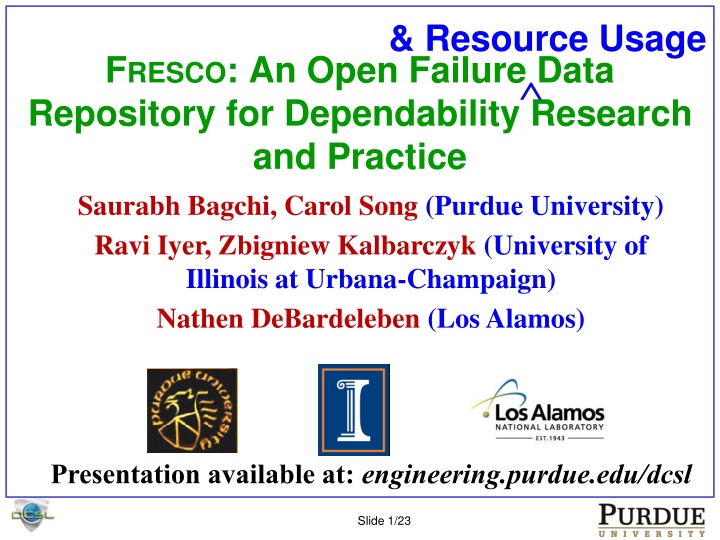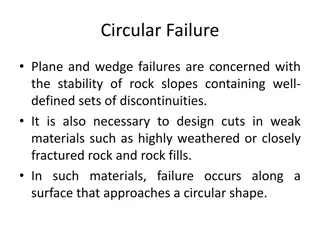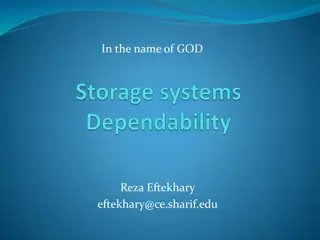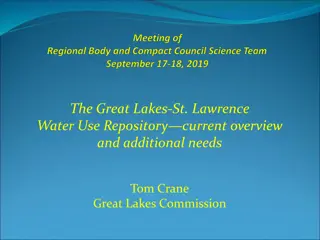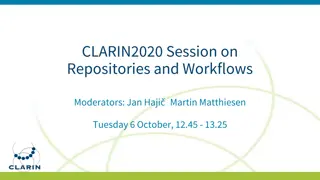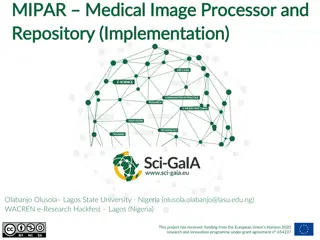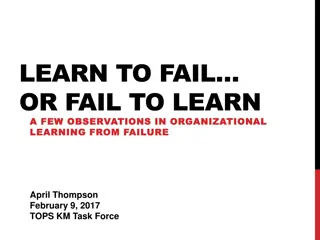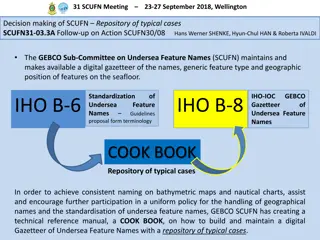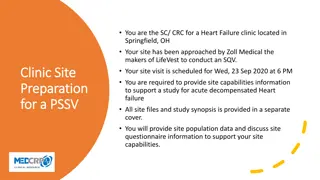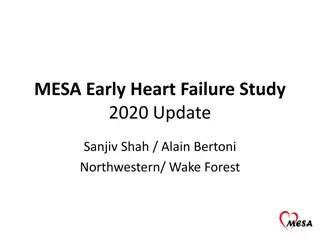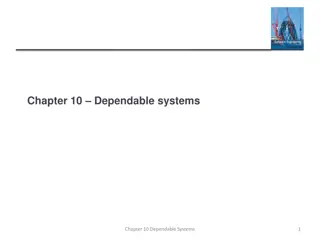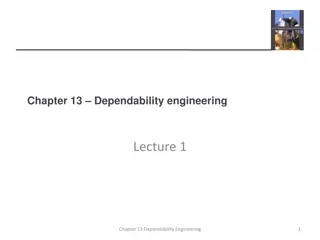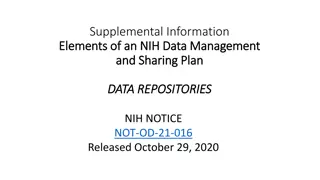Open Failure Data Repository for Dependability Research
An overview of FRESCO, an open failure data repository for research on dependability in computing systems. Motivations, plans, and initiatives to collect and share data to enhance system design and reliability.
Download Presentation

Please find below an Image/Link to download the presentation.
The content on the website is provided AS IS for your information and personal use only. It may not be sold, licensed, or shared on other websites without obtaining consent from the author.If you encounter any issues during the download, it is possible that the publisher has removed the file from their server.
You are allowed to download the files provided on this website for personal or commercial use, subject to the condition that they are used lawfully. All files are the property of their respective owners.
The content on the website is provided AS IS for your information and personal use only. It may not be sold, licensed, or shared on other websites without obtaining consent from the author.
E N D
Presentation Transcript
& Resource Usage FRESCO: An Open Failure Data Repository for Dependability Research and Practice Saurabh Bagchi, Carol Song (Purdue University) Ravi Iyer, Zbigniew Kalbarczyk (University of Illinois at Urbana-Champaign) Nathen DeBardeleben (Los Alamos) Presentation available at: engineering.purdue.edu/dcsl Slide 1/23
Roadmap Motivation Why do we need an open data repository? What are our plans Context Large computing cluster at Universities Demography of the cluster users Challenge in supporting user needs Insights from analysis of Purdue s cluster Cluster environment The data set Analysis and Results Current status of the repository The next steps Slide 2/23
Motivation Dependability has become a necessary requisite property for computing systems that we rely on Dependable system design should be based on real failure modes of systems BUT There does not exist any open failure data repository today for any recent computing infrastructure that is large enough, diverse enough, and with enough information about the infrastructure and the applications that run on them Slide 3/23
So what do we do about it? 1. Stop bemoaning the lack of publicly available dependability dataset and start building one 2. But, who will want to share such data publicly? 3. Start with local IT organizations: Purdue and UIUC 4. Get NSF backing some of the IT clusters have been set up with NSF funding 5. Collect an initial dataset for a small time window of 1. Applications and libraries 2. Resource usage node and job level 3. Health information node and job level 6. Release the dataset after heuristic-based anonymization Slide 4/23
National Science Foundation Context Planning grant from the National Science Foundation (NSF) in 06/14-06/15, $100K Computational and Information Sciences Directorate (CISE) Computing Research Infrastructure (CRI) Program Deliverable: Data collection tools in place on Purdue s IT infrastructure; Requirements gathering Regular grant from NSF: 3 years, started 07/15, $1.2M Involves UIUC with their Blue Waters cluster Delivered: First release of the dataset with DOI Deliverable: Large set of diverse data, from the PI/co-PI s institutions plus others Large set of users Large set of analytical tools made available by the community Slide 5/23
University Compute Cluster Context Computing clusters at university is not uncommon Users have a varying level of expertise Writing own job scripts Using scripts like a black box Varying user needs High computation power Analysis of large structures (Civil, Aerospace engineering) High Lustre bandwidth for file operations Working with multiple large databases/files (Genomics) High Network Bandwidth A parallel processing application Slide 6/23
Goals of Data Analysis & Related Efforts Goals for data analysis of cluster resource usage and failures Improve cluster availability Minimize the maintenance cost ``Customer satisfaction Several synergistic efforts XDMoD (U of Buffalo): NSF-funded project to audit utilization of the XSEDE cyberinfrastructure by providing a wide range of metrics on XSEDE resources, including resource utilization, resource performance, and impact on scholarship XALT (U of Chicago, UT Austin): NSF-funded project to collect and understand job-level information about the libraries and executables that jobs use [Past project] Computer Failure Data Repository (CFDR) (CMU, U of Toronto) Slide 7/23
Purdue Cluster Details and Initial Dataset Slide 8/23
Cluster Details Purdue s cluster is called Conte 580 homogeneous nodes Each node contains two 8 core Intel Xeon E5-2670 Sandy Bridge processors running at 2.6 GHz Two Xeon Phi 5110P accelerator card, each with 60 cores Memory: 64GB of DDR3, 1.6 GHz RAM 40Gbps FDR10 Infiniband interconnect along with IP Lustre file system, 2GB/s RHEL 6.6 PBS based job scheduling using Torque Conte is a ``Community cluster Slide 9/23
Cluster Details Scheduling in Conte: Each job requests for certain time duration, number of nodes and in some cases, amount of memory needed When job exceeds the specified time limit, it is killed Jobs are also killed by out-of-memory (OOM) killer scripts, if it exhausts available physical memory and swap space Node sharing: By default only a single job is scheduled on a an entire node giving dedicated access to all the resources However, user can enable sharing by using a configuration in the job submission scripts Slide 10/23
Contes Data Set Data set spans Oct 14 Mar 15 (6 months) ~500k jobs (489, 971 jobs) 306 unique users Per job data Accounting logs from PBS scheduler Job owner details Start/end time, resource requested/used List of shared libraries used (using lsof) Node-wise performance data Collected using Tacc stats Lustre, Infiniband, Virtual memory, Memory and more Syslog messages Slide 11/23
System Usage Repository Objectives Enable systems research in dependability that relies on system usage and failure records from large-scale systems Provide synchronized workload information, system usage information, some user information, hardware status information Provide this repository for a diversity of workloads and diversity of computing systems Provide common analytic tools to allow for dependability- related questions to be asked of the data URL: https://diagrid.org/resources/247 Slide 12/23
Questions for the Repository URL: https://diagrid.org/resources/247 What is the resource utilization (CPU, memory, network, storage) of jobs with a certain characteristic? Characteristic could be the application domain, the libraries being used, parallel or serial, and if parallel, how many cores We want to know this especially if resource utilization is anomalously high What is the profile of users submitting jobs to the cluster? Are they asking for too much or too little resources in the submission script? Are they making the appropriate use of the parallelism? What kinds of problem tickets do they submit and how many rounds are needed to resolve these tickets? Slide 13/23
Current status of the repository Workload traces from Conte Accounting information (Torque logs) TACC stats performance data User documentation Privacy Anonymize machine specific information Anonymize user/group identifiers Library list is not shared For privacy reasons Slide 14/23
Insights from Data Analysis Few libraries (not pre-installed) are highly popular 45% jobs use less than 10% requested time 70% jobs use less than 50% requested memory 20% jobs showed memory thrashing Memory thrashing behavior of jobs the share the node and jobs that do not are exactly opposite Few jobs place very high demand for I/O and network resources Slide 15/23
Hot Libraries Extract all dynamically linked libraries being used by the applications Sorted histogram of top 500 libraries as used by the jobs 1. 2. Out of a total 3,629 unique libraries, some are used much more often Each of the top 50 libraries is used by more than 80 % of the users Slide 16/23
Resource Request Patterns Percentage of the user requested time actually used by the jobs 1. Almost 45% of jobs actually used less than 10% of requested time 2. But, scheduler during busy periods gives higher priority to shorter jobs Slide 17/23
Shared v/s non-shared Jobs Jobs that share node have higher thrashing compared to jobs that do not share the node Slide 18/23
Project Plans Slide 19/23
Immediate next steps Continued data collection on Purdue clusters Analysis of Blue Waters logs Analyze workloads on similar lines as Conte Investigate the similarities and differences in the results Identify the user behavior and workload characteristic for better cluster management Close the loop Implement the remediation measures, e.g., move some jobs to a different cluster, increase the memory asked for Check the effect of the remediation measures Slide 20/23
A Wish List for Types of Data Accounting information Job Owner ID, group ID Start/End time Resources requested/used Memory, CPUs, Walltime ,etc Performance statistics I/O usage (Lustre, Disk) Network usage (IP, Infiniband) Memory usage Virtual memory statistics Library List per job Shared objects used by the job Slide 21/23
A Wish List for Types of Data User Tickets Problem and resolution Failure resolution reports Failure description Root cause identification Issue resolution Slide 22/23
Conclusion It is important to analyze how resources are being utilized by users Scheduler tuning, resource provisioning, and educating users It is important to look at workload information together with failure events Workload affects the kinds of hardware-software failures that are triggered Open repository enables researchers for different kind of analyses to enhance system dependability Purdue: Suhas Javagal, Subrata Mitra, Chris Thompson, Stephen Harrell, Chuck Schwarz UIUC/NCSA: Saurabh Jha, Joseph Fullop, Jeremy Enos, Fei Deng, Jin Hao DOE: Todd Gamblin, Ignacio Laguna, Dong Ahn Contributors Slide 23/23
Thank you Slide 24/23
